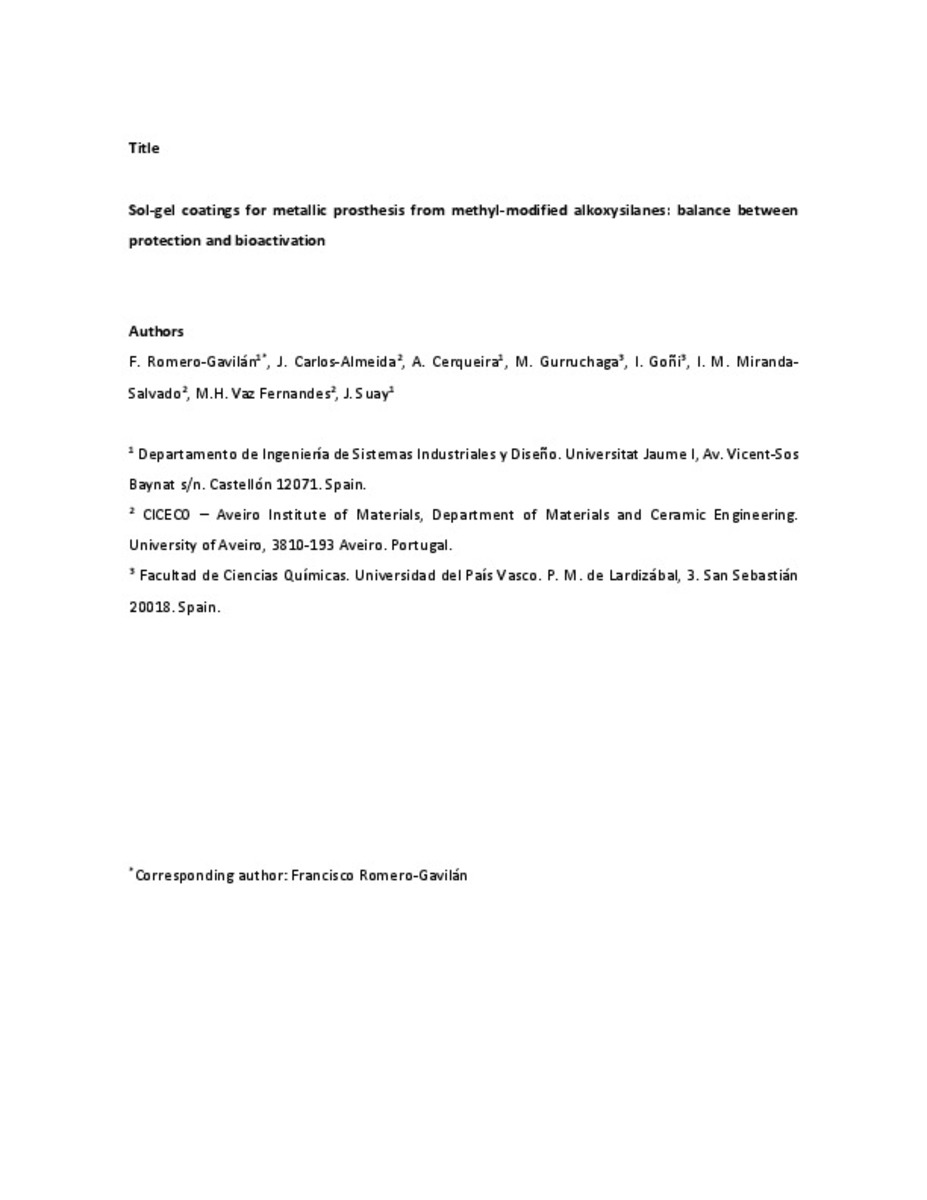Mostrar el registro sencillo del ítem
Sol-gel coatings for metallic prosthesis from methyl-modified alkoxysilanes: balance between protection and bioactivation
| dc.contributor.author | Romero-Gavilán, Francisco J | |
| dc.contributor.author | Carlos-Almeida, J. | |
| dc.contributor.author | Cerqueira, Andreia | |
| dc.contributor.author | GURRUCHAGA, MARILO | |
| dc.contributor.author | Goñi, Isabel | |
| dc.contributor.author | Miranda-Salvado, I. M. | |
| dc.contributor.author | Vaz Fernandes, M. H. | |
| dc.contributor.author | Suay, Julio | |
| dc.date.accessioned | 2020-07-09T09:28:13Z | |
| dc.date.available | 2020-07-09T09:28:13Z | |
| dc.date.issued | 2020 | |
| dc.identifier.citation | ROMERO-GAVILÁN, F., et al. Sol-gel coatings made using methyl-modified alkoxysilanes: The balance between protection and bioactivation. Progress in Organic Coatings, 2020, vol. 147, p. 105770. | ca_CA |
| dc.identifier.issn | 0300-9440 | |
| dc.identifier.uri | http://hdl.handle.net/10234/189066 | |
| dc.description.abstract | The reported osteogenic properties of the hybrid silica sol-gel materials make these compositions perfect candidates for bone tissue engineering applications. The aim of this study was the synthesis and characterisation of hybrid silica coatings, obtained using mixtures of tetraethyl orthosilicate (TEOS) and three different methyl-modified alkoxysilanes: trimethoxymethylsilane (MTMS), dimethyldiethoxysilane (DMDES) or polydimethylsiloxane (PDMS). A comparison of the properties of these materials can reveal the best candidate for the coatings on metallic prostheses. After optimising the synthesis parameters, the developed coatings were characterised using Fourier transform infrared spectrometry (FT-IR), 1H and 29Si solid-state nuclear magnetic resonance (1H-NMR and 29Si-MNR), cross-cut tests, scanning electron microscopy (SEM), contact angle measurements, optical profilometry, hydrolytic degradation tests and electrochemical corrosion analysis. Homogeneous and well-adhering coatings were obtained using the three methyl-modified reagents. However, different degrees of protection against corrosion, different hydrophilicity and varying degradation kinetics were observed for different precursors. The MTMS-based coating showed the highest hydrophilicity and degradation kinetics; these properties can be associated with increased bioactivity (Si release). In contrast, the PDMS and DMDES-based coatings showed augmented resistance to corrosion and lower permeability to water and, consequently, improved protection of metallic surfaces. From the physicochemical point of view, all these materials displayed interesting characteristics, relevant for coatings to be used in biomedical applications. | ca_CA |
| dc.format.extent | 28 p. | ca_CA |
| dc.format.mimetype | application/pdf | ca_CA |
| dc.language.iso | eng | ca_CA |
| dc.publisher | Elsevier | ca_CA |
| dc.relation.isPartOf | Progress in Organic Coatings, 2020, vol. 147. | ca_CA |
| dc.rights | 0300-9440/ © 2020 Elsevier B.V. All rights reserved | ca_CA |
| dc.rights.uri | http://rightsstatements.org/vocab/InC/1.0/ | * |
| dc.subject | Hybrid sol-gel | ca_CA |
| dc.subject | Biomaterials | ca_CA |
| dc.subject | Alkoxysilane | ca_CA |
| dc.subject | Metal prosthesis | ca_CA |
| dc.subject | Corrosion resistance | ca_CA |
| dc.subject | Coating | ca_CA |
| dc.title | Sol-gel coatings for metallic prosthesis from methyl-modified alkoxysilanes: balance between protection and bioactivation | ca_CA |
| dc.type | info:eu-repo/semantics/article | ca_CA |
| dc.identifier.doi | https://doi.org/10.1016/j.porgcoat.2020.105770 | |
| dc.relation.projectID | AT2017-86043-R, E-2016-3, UFI11/56, IT611-13, UID/CTM/ 50011/2019 | ca_CA |
| dc.rights.accessRights | info:eu-repo/semantics/openAccess | ca_CA |
| dc.relation.publisherVersion | https://www.sciencedirect.com/science/article/pii/S0300944019317515 | ca_CA |
| dc.type.version | info:eu-repo/semantics/submittedVersion | ca_CA |
Ficheros en el ítem
Este ítem aparece en la(s) siguiente(s) colección(ones)
-
ESID_Articles [472]







